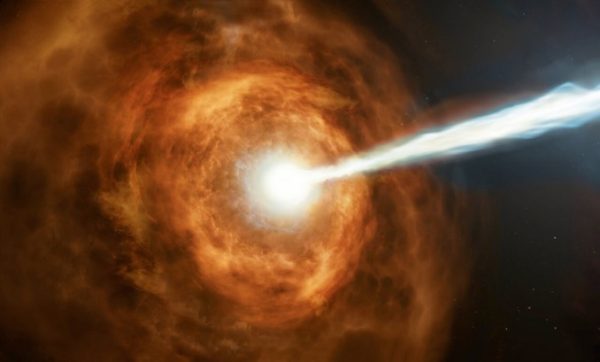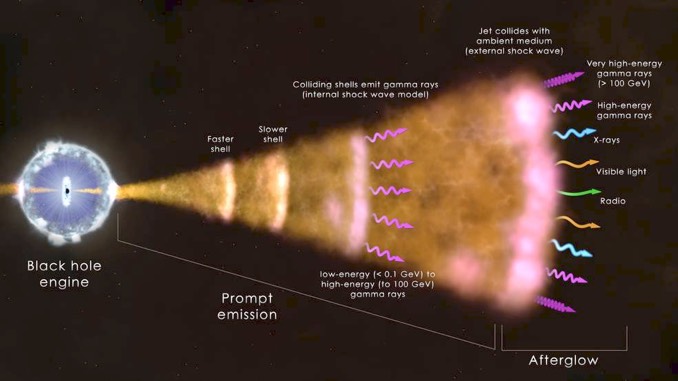Astronomers thrilled by most powerful gamma ray burst to date – Astronomy Now Online

On 14 January, a suite of space- and ground-based telescopes detected the most powerful gamma ray burst ever seen, an mind-boggling flash from an exploding star that released more energy in a few seconds than the Sun will generate over its entire 10-billion-year life. The detected radiation was up to a trillion times more energetic than visible light.
The unusually brilliant and long-lived gamma ray burst, known as GRB 190114C, was studied by a suite of instruments, starting with NASA’s Swift and Fermi spacecraft as well as the Major Atmospheric Gamma Imaging Cherenkov – MAGIC – telescopes on the Canary islands. Follow-up observations of the environment around the GRB were carried out by the Hubble Space Telescope.
“Hubble’s observations suggest that this particular burst was sitting in a very dense environment, right in the middle of a bright galaxy 5 billion light years away,” said Andrew Levan of the Institute for Mathematics, Astrophysics and Particle Physics at Radboud University in the Netherlands. “This is really unusual, and suggests that this concentrated location might be why it produced this exceptionally powerful light.”
The observations were described in papers published in the journal Nature and accepted for publication by The Astrophysical Journal.
Gamma ray bursts are believed to be generated when the cores of massive stars run out of nuclear fuel and collapse, blowing away their outer atmospheres while the cores collapse to form black holes. GRBs also may be triggered when neutron stars crash together. The burst of gamma rays occurs when jets of high-energy particles accelerated to more than 99 percent the speed of light slam into the surrounding atmosphere, creating a titanic shock.

Initially discovered by military satellites on the lookout for nuclear detonations on Earth, gamma ray bursts are extraordinarily difficult to observe from Earth’s surface because such high-energy radiation is effectively absorbed by the planet’s atmosphere. That forces astronomers to rely on satellite-borne instruments to study the details of GRBs.
While direct observations from Earth’s surface are not feasible, astronomers can indirectly detect gamma rays by monitoring the atmosphere for signs of Cherenkov radiation, the blue glow produced when gamma rays slam into other atoms and molecules. Such collisions can trigger a “shower” of subatomic particles in the upper atmosphere, imparting enough energy for some to briefly travel faster than light in air (not in vacuum, of course).
On 20 July 2018, gamma rays in the dim afterglow of GRB 180720B were observed by the High-Energy Stereoscopic System – H.E.S.S. – observatory’s 28-metre radio telescope in Namibia. Then, on 14 January 2019, a bright emission from GRB 190114C was detected by the Major Atmospheric Gamma Imaging Cherenkov – MAGIC – telescopes at La Palma.
Both GRBs were initially spotted by a NASA satellite and later determined to be 5 billion and 4 billion light years from Earth respectively. The astronomical community was notified and “we were able to point to the region of origin so quickly that we could start observing only 57 seconds after the initial detection of the explosion,” said Cosimo Nigro, a MAGIC researcher at DESY, the Deutsches Elektronen-Synchotron research centre. “In the first 20 minutes of observation, we detected about a thousand photons from GRB 190114C.”

The MAGIC instrument detected gamma rays with energies between 200 billion and 1 trillion electron volts. To put that in perspective, a trillion electron volts is roughly equivalent to the energy carried by a flying mosquito. While that might not sound like much, that energy is concentrated in a single particle.
“These are by far the highest energy photons ever discovered from a gamma-ray burst,” said Elisa Bernardini, leader of the MAGIC group at DESY.
It is not yet clear how such extreme energies are generated. The researchers assume a two-stage process in which electrically charged particles are deflected in an exploding star’s magnetic fields, producing so-called synchrotron radiation. That radiation, in turn, collides with other particles to produce the observed energies.
“For the first time, the two instruments have measured gamma radiation from gamma-ray bursts from the ground,” said David Berge, head of gamma-ray astronomy at DESY. “These two groundbreaking observations have established gamma-ray bursts as sources for terrestrial gamma-ray telescopes. This has the potential to significantly advance our understanding of these violent phenomena.”





